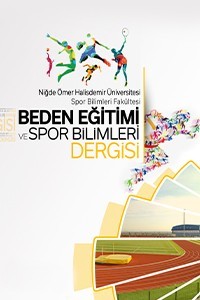NORMAL GELİŞEN KİLOLU VE OBEZ ERGENLERDE CİNSİYETİN İNCE VE KABA MOTOR BECERİLERE ETKİSİ
Motor gelişim, Obez, Fazla kilolu, Cinsiyet, Ergen
GENDER DIFFERENCES IN FINE AND GROSS MOTOR SKILLS OF NORMALLY DEVELOPING OVERWEIGHT AND OBESE ADOLESCENTS
Motor development, Obese, Overweigth, Gender, Adolescents,
___
- 1. Connolly, B.H., Montgomery, P. Therapeutic exercise in developmental disabilities. In Montgomery (Eds.) New Jersey: SLACK Incorporated. pp. 2-225, 2005.
- 2. Haywood, K.M., Getchell, N. Life span motor development 5th ed., Champaign, Illinois: Human Kinetics,p.4, 2009.
- 3. Gallahue, D., Ozmun, J. Understanding motor development: ınfants, children,adolescents, adults. 6th ed., New York: Mc Graw Hill, pp: 53, 287-327, 2006.
- 4. Cools,W., Martelaer, De K., Samaey, C., Andries, C. Movement skill assessment of typically developing preschool children: a review of seven movement skill assessment tools. Journal of Sports Science & Medicine;8(2):154–168, 2009.
- 5. Summers, J., Larkin, D., Dewey, D. Activities of daily living in children with developmental coordination disorder: dressing, personal hygiene, and eating skills. Human movement science, 27(2), pp.215–229, 2008.
- 6. Daştan, İ., Çetinkaya, V., Delice, M.E. İzmir ilinde 7-18 yaş arası öğrencilerde obezite ve fazla kilo prevalansı. Bakırköy Tıp Dergisi 2014;10:139- 146. [In Turkish]
- 7. Reilly, J.J., Kelly, L., Montgomery, C., Williamson, A., Fisher, A., McColl, J.H., Conte, L.R., Paton, Y.J., Grant, S. Physical activity to prevent obesity in young children: cluster randomised controlled trial. BMJ, 18;333(7577):1041, 2006.
- 8. Okely, A.D., Booth, M.L., Chey, T. Relationships between body composition and fundamental movement skills among children and adolescents. Res Q Exerc Sport, 75(3):238-47, 2004a.
- 9. Krombholz H. Motor and cognitive performance of overweight preschool children. Percept Mot Skills, 116(1):40-57, 2013.
- 10. Gentier I, D'Hondt E, Shultz S, Deforche B, Augustijn M, Hoorne S, Verlaecke K, De Bourdeaudhuij I, Lenoir M. Fine and gross motor skills differ between healthyweight and obese children. Res Dev Disabil, 34(11):4043-51, 2013.
- 11. Prskalo, I., Badrić, M., Kunješić, M. The percentage of body fat in children and the level of their motor skills, Coll Antropol, 39 Suppl 1:21- 8, 2015.
- 12. Okely, I., Booth, M.L. South Wales: prevalence and sociodemographic distribution. J Sci Med Sport;7:3:358-372, 2004b.
- 13. Gidley Larson, J.C., Mostofsky, S.H., Goldberg, M.C. Effects of gender and age on motor exam in typically developing children. dev neuropsycho,l 32(1): 543–562, 2007.
- 14. Barnett, L.M., Beurden, E., Morgan, P.J. O., Brooks, L., Beard, J.R. Gender differences in motor skill proficiency from childhood to adolescence. Research Quarterly for Exercise and Sport, 81(2), 162–170, 2010.
- 15. Krebs, N.F., Himes, J.H., Jacobson, D., Nicklas, T.A., Guilday, P., Styne, D. Assessment of child and adolescent overweight and obesity. Pediatrics, 120:(suppl 4) S193-S228, 2007.
- 16. Bruininks, R.H., Bruininks, B.D. BruininksOseretsky test of motor proficiency. examiners manual (2nd ed.). Circle Pines MN: American Guidance Service Inc., 2005.
- 17. Gaul, D. Fine motor skill performance in Irish childre. Dublin City University, Master of Sciences Thesis, 2014.
- 18. Maitland, C., Stratton, G., Foster, S., Braham, R., Rosenberg, M. A place for play? The influence of the home physical environment on children’s physical activity and sedentary behaviour. The International Journal of Behavioral Nutrition and Physical Activity, 10: 99–120, 2013.
- 19. Hume,C., Okely, A., Bagley, S. Does weight status influence associations between children’s fundamental movement skills and physical activity? Research Quarterly for Exercise and Sport, 79(2): 158–165, 2008.
- 20. Thomas, J.R., French, K.E. Gender differences across age in motor performance a meta-analysis. Psychological Bulletin, 98(2), pp.260–282, 1985.
- 21. Beunen, G., Thomis, M. Muscular strength development in children and adolescents. Pediatric exercise science, 12, 174–197, 2000.
- 22. Ercan, S., Dallar, Y.B., Onen, S., Engiz, O. Prevalence of obesity and associated risk factors among adolescents in Ankara, Turkey. J Clin Res Pediatr En docrinol, 4(4):204-207, 2012.
- 23. Stodden, D.F., Goodway, D.J., Langendorfer, J.S., Roberton, A.M., Rudisill, E.M. Garcia, C., Garcia, E.L. A developmental perspective on the role of motor skill competence in physical activity: an emergent relationship. Quest , 60(2):290–306, 2008.
- ISSN: 1307-6477
- Yayın Aralığı: Yılda 3 Sayı
- Başlangıç: 2007
- Yayıncı: Niğde Ömer Halisdemir Üniversitesi
Çağrı Hamdi ERDOĞAN, Ziya BAHADIR
FARKLI ZEMİNLERİN 14-16 YAŞ VOLEYBOLCULARDA SIÇRAMA BECERİSİNE ETKİSİNİN KARŞILAŞTIRILMASI
Ülviye BİLGİN, İmdat YARIM, Ebru ÇETİN
Gülcan HARPUT, Fatma Filiz ÇOLAKOĞLU, Gül BALTACI
BASKETBOL VE HENTBOL TAKIM OYUNCULARININ AEROBİK, ANAEROBİK GÜÇ ÖZELLİKLERİNİN KARŞILAŞTIRILMASI
Gürhan SUNA, Malik BEYLEROĞLU, Kürşat HAZAR
GENÇLİK MERKEZİ FAALİYETLERİNE KATILAN BİREYLERİN SERBEST ZAMAN TATMİN DÜZEYLERİNİN İNCELENMESİ
Bilal YAMAN, Beyza Merve AKGÜL, Merve KARAMAN, Tebessüm AYYILDIZ, Suat KARAKÜÇÜK
Levent BAYRAM, Deniz Özge Yüceloğlu KESKİN, Deniz Günay DEREBAŞI
SPORCU ÖĞRENCİLERİNİN SPOR BRANŞLARINA GÖRE KİŞİLİK ÖZELLİKLERİ
Fethiye TOSUNOĞLU, Belgin GÖKYÜREK, İlyas OKAN
Hacı Şükrü TAŞTAN, Hanife Banu Ataman YANCI
DÜZ ALANDA YAPILAN ANTRENMAN İLE FARTLEK ANTRENMANIN MAKSİMAL OKSİJEN TÜKETİM KAPASİTESİNE ETKİSİ
